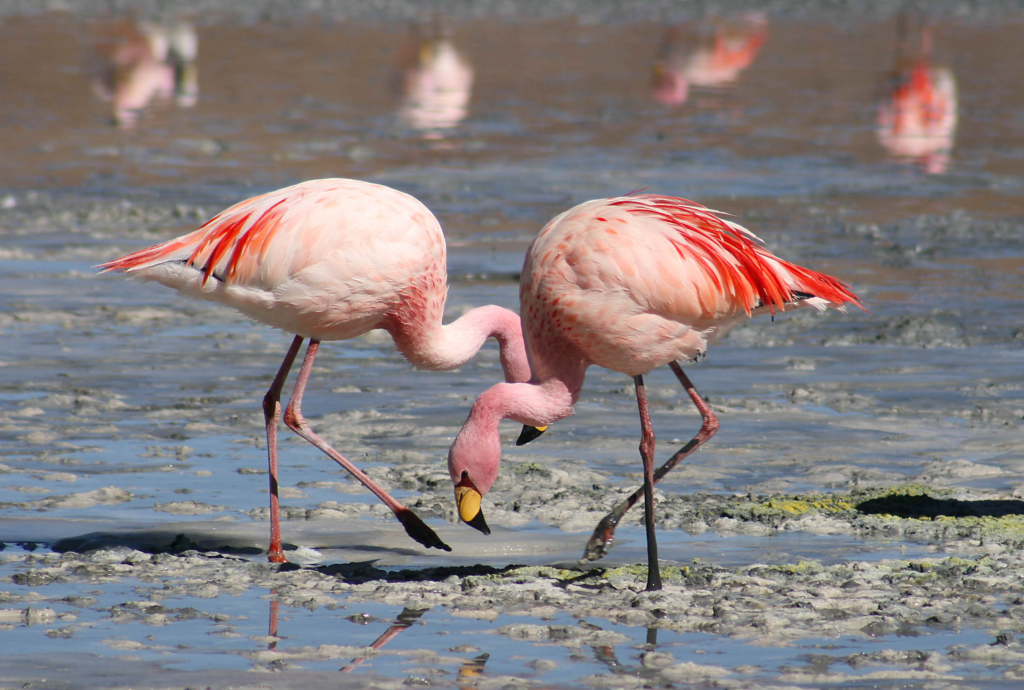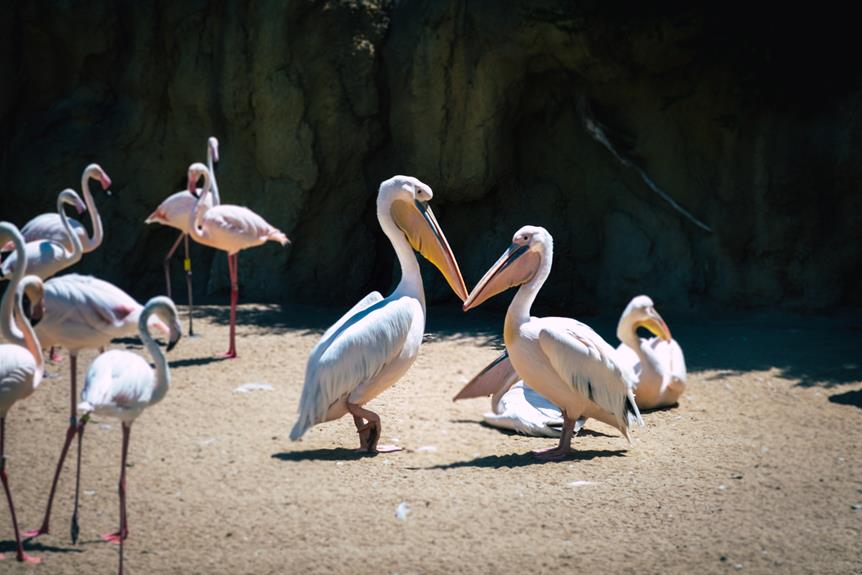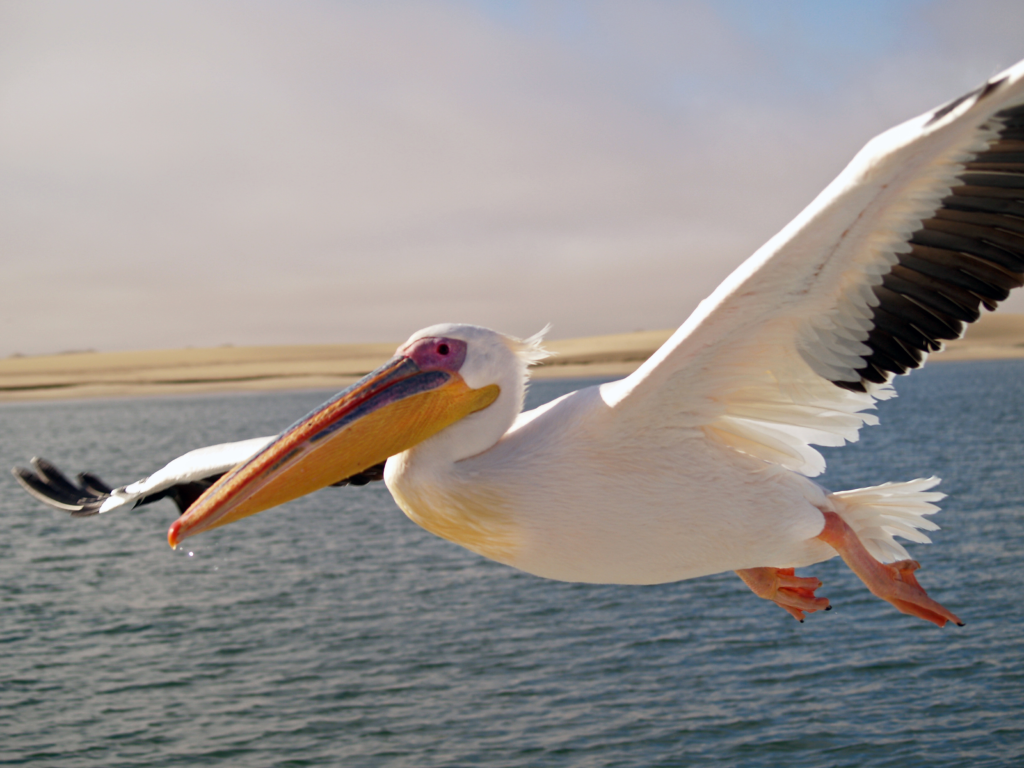In the realm of water birds, few creatures captivate the imagination quite like flamingos, pelicans, and cranes. With their unique physical characteristics and distinct feeding habits, these avian species stand out as icons of nature’s ingenuity.
From the filter beaks of flamingos and pelicans to the remarkable migratory abilities of cranes, each bird brings its own remarkable contribution to the vast tapestry of avian life.
Join us as we delve into the captivating world of these water birds and explore the fascinating differences that make them so extraordinary.
Key Takeaways
- Flamingos, pelicans, and cranes are all types of water birds.
- Flamingos have a specialized beak for filter-feeding on brine shrimp and blue-green algae, while pelicans have a beak with a throat pouch for catching and storing fish.
- Cranes are known for their ability to migrate over long distances and the Sarus crane is the world’s tallest flying bird.
- There are four species of crane birds found in India and some crane species, like the Siberian crane, make the longest distance migrations.
Summary: Difference Between Flamingos,Pelicans and Cranes
| Aspect | Flamingos | Pelicans | Cranes |
|---|---|---|---|
| Family and Subfamily | Phoenicopteridae | Pelecanidae | Gruidae |
| Beak Structure | Specialized filter beak for filter-feeding | Beak with throat pouch for fish catching | Long bills for probing and catching prey |
| Primary Feeding Habit | Filter-feeding on brine shrimp and algae | Fish catching and storage in throat pouch | Varied diet including insects and plants |
| Preferred Habitat | Saline or alkaline lakes, estuaries, lagoons | Coastal areas, lakes, rivers | Wetlands, grasslands, marshes |
| Geographic Range | Africa, the Americas, Europe, Asia | Worldwide, spanning North and South America, Europe, Africa, Asia | Different species in various regions |
| Migration Patterns | Migrate to find suitable breeding sites | Migrate based on fish availability | Undertake long-distance migrations |
| Conservation Concerns | Habitat loss, pollution, climate change, disturbance | Habitat loss, pollution, overfishing, disturbance | Habitat loss, climate change, hunting |
| Conservation Strategies | Protected areas, habitat restoration, management | Habitat preservation, anti-poaching measures, research | Wetland conservation, international collaborations, public awareness |
Physical Characteristics
Flamingos, pelicans, and cranes exhibit distinct physical characteristics that set them apart from each other.
When comparing their beak structures, flamingos possess a unique filter beak that allows them to feed on brine shrimp and blue-green algae. This specialized beak is adapted to their filter-feeding habits in aquatic environments.

On the other hand, pelicans have a beak with a throat pouch, which they use to catch and store fish. This adaptation enables pelicans to thrive in coastal and inland waters, where they can efficiently catch fish for sustenance.
Cranes, with their long-necked and long-legged bodies, have evolved for their remarkable ability to migrate over long distances. These physical attributes allow them to cover vast geographical ranges during their seasonal migrations.
Feeding Habits
The feeding habits of pelicans, cranes, and flamingos differ significantly due to their distinct beak structures and dietary preferences.
Flamingos are filter feeders that use their uniquely shaped beaks to filter out small organisms, such as brine shrimp and blue-green algae, from the water. They often feed by dipping their heads upside down into the water, filtering out food with comb-like structures called lamellae.
Pelicans have a beak with a throat pouch that they use for fish catching. They plunge their beaks into the water to catch fish, then squeeze out the water and swallow the fish whole. Their throat pouch can hold large amounts of fish, allowing them to store food for later consumption.
Cranes have a varied diet that includes insects, small mammals, reptiles, amphibians, and plants. They use their long bills to probe and catch prey on the ground or in shallow water. Cranes are opportunistic feeders and can adapt their feeding habits based on food availability in their habitat.
These unique feeding adaptations allow each bird species to thrive in their specific habitats and obtain the necessary nutrients for their survival and reproduction.
Habitat and Distribution
Pelicans, cranes, and flamingos have distinct habitats and distributions that are influenced by their specific ecological requirements and migratory behaviors.
Pelicans are found in various parts of the world, with their geographic range spanning across North and South America, Europe, Africa, and Asia. They prefer habitats such as coastal areas, lakes, and rivers, where they can easily find fish to feed on.
Cranes, on the other hand, have a more limited geographic range, with different species being found in different parts of the world. They are known to inhabit wetlands, grasslands, and marshes, and some species undertake long-distance migrations to find suitable breeding grounds.
Flamingos, known for their distinctive pink plumage, are primarily found in parts of Africa, the Americas, Europe, and Asia. They prefer habitats such as saline or alkaline lakes, estuaries, and lagoons, where they can feed on algae and small invertebrates.
Migration Patterns
Cranes, pelicans, and flamingos are water birds that exhibit distinct migration patterns. These patterns are crucial in understanding their breeding behavior and how they are affected by environmental factors. Here are some key points regarding the migration patterns of these birds:
- Cranes undertake long-distance migrations, covering thousands of kilometers and often crossing continents.
- Pelicans migrate in search of suitable feeding grounds, following the availability of fish populations.
- Flamingos migrate to find suitable breeding sites, where they form large colonies and engage in courtship displays.
- Environmental factors such as temperature, food availability, and water levels play a significant role in determining the timing and duration of these migrations.
- Some species of cranes, pelicans, and flamingos migrate in large flocks, displaying remarkable coordination and navigation skills.
Understanding the migration patterns of these birds provides insights into their adaptation strategies and highlights the importance of conserving their habitats along their migratory routes.
Conservation Status
The conservation status of flamingos, pelicans, and cranes is of paramount importance in ensuring the long-term survival of these iconic water birds. These species face several threats that have led to population declines in recent years.
Habitat loss and degradation, caused by factors such as urbanization, agriculture, and pollution, pose significant challenges to their survival. Climate change also poses a threat, as it alters the availability of suitable breeding and foraging grounds. Additionally, illegal hunting and egg collection further contribute to the decline in population numbers.
To address these threats, various conservation efforts are underway. These efforts include the establishment of protected areas, such as national parks and wildlife sanctuaries, as well as the implementation of conservation strategies aimed at habitat restoration and management. International collaborations and awareness campaigns are also essential in raising public consciousness and promoting the conservation of these magnificent water birds.
Frequently Asked Questions
What Is the Lifespan of a Flamingo, Pelican, and Crane?
The lifespan of a flamingo, pelican, and crane varies. Flamingos can live up to 40 years, while pelicans can live up to 30 years. Cranes have a longer lifespan, with some species living up to 50 years or more.
How Do Flamingos, Pelicans, and Cranes Communicate With Each Other?
Flamingos, pelicans, and cranes communicate through a variety of methods, such as vocalizations, body language, and displays. Flamingos use vocalizations and synchronized movements, while pelicans communicate through bill clapping and head movements. Cranes have elaborate mating dances and vocalizations to communicate.
Are Flamingos, Pelicans, and Cranes Endangered Species?
Flamingos, pelicans, and cranes are not currently classified as endangered species. However, conservation efforts for flamingos focus on protecting their habitats and reducing human disturbance, while pelican migration patterns are studied to ensure their survival and well-being.
Can Flamingos, Pelicans, and Cranes Fly Long Distances Without Resting?
Flamingos, pelicans, and cranes possess remarkable adaptations for long-distance flight. They exhibit distinct migration patterns, with flamingos relying on their filter beaks, pelicans utilizing their throat pouches, and cranes showcasing their ability to migrate over vast distances without resting.
Do Flamingos, Pelicans, and Cranes Have Any Predators in Their Habitats?
Flamingos, pelicans, and cranes have various predators in their habitats. Predator-prey relationships play a crucial role in their survival. These birds have developed adaptations such as flight, camouflage, and group behavior to evade or defend against their predators.
Conclusion
In conclusion, the distinct physical characteristics, feeding habits, habitat and distribution, and migration patterns of flamingos, pelicans, and cranes highlight the rich diversity of water bird species.
These avian groups play important ecological roles in different ecosystems, from filter feeding on brine shrimp and algae to catching and storing fish, and from inhabiting wetlands to undertaking remarkable migratory journeys.
Understanding these differences helps us appreciate the remarkable adaptations and ecological significance of these fascinating avian species.



